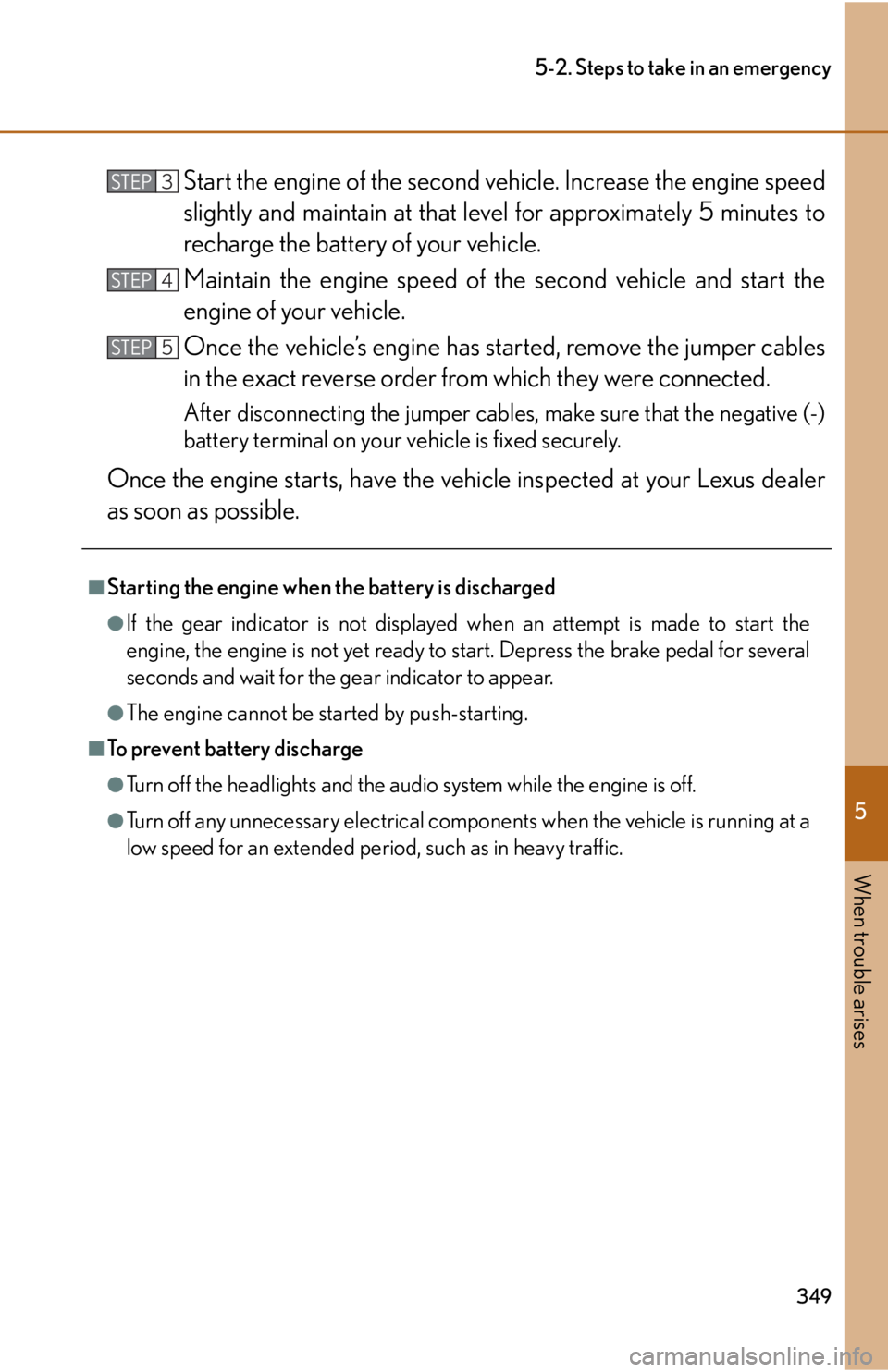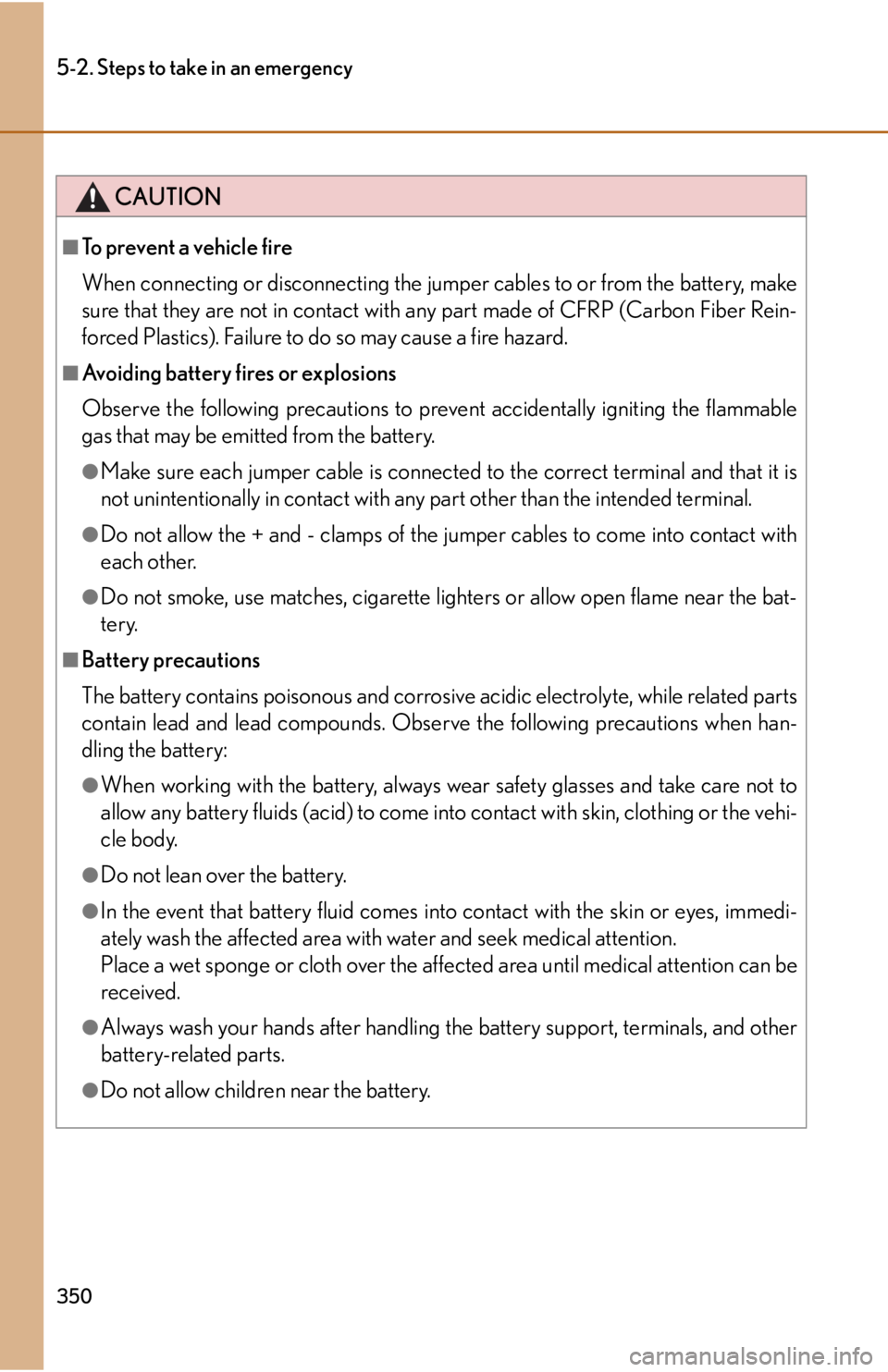Page 342 of 420

340
5-2. Steps to take in an emergency
■Sealant
●One tire can be repaired using the bottle of sealant stored in the emergency tire
puncture repair kit.
●The sealant can be used when the outside temperature is from -22°F (-30°C)
to 140°F (60°C).
●When the outside temperature is low, the viscosity of the sealant becomes high
and it will be more difficult to inject th e sealant. In this case, warm the sealant in
the vehicle before using it.
●The sealant has a limited lifespan. The expi ration date is marked on the bottle.
The sealant should be replaced before the expiration date. Contact your Lexus
dealer.
●If the sealant gets on your clothes, it may stain.
●After using the sealant, bring the empty bottle of sealant to your Lexus dealer
and purchase a new bottle. Keep the ne w bottle of sealant in your vehicle.
■Compressor
●The compressor is a pneumatic filling type for passenger vehicles.
●When the compressor is operating, a loud operating noise will be produced.
This does not indicate a malfunction.
■The wheel of a tire that has been repaired
If you remove the sealant adhering to the wheel with a rag, you can reuse the wheel.
■The valve of a tire that has been repaired
●After a tire is repaired with the emergency tire puncture repair kit, the tire pres-
sure warning valve and transm itter should be replaced.
●After a tire is repaired with the emergency tire puncture repair kit, even if the
tire inflation pressure is at the recommended level, the tire pressure warning
light may come on/flash.
Page 345 of 420

5
When trouble arises
343
5-2. Steps to take in an emergency
If the engine will not start
If the engine will not start, even though correct starting procedures are being
followed (
P. 98), consider each of the following points.
■ The engine will not start even when the starter motor operates nor-
mally.
One of the following may be the cause of the problem.
● There may not be sufficient fuel in the vehicle’s tank.
Refuel the vehicle.
● The engine may be flooded.
Try to restart the engine once more following correct starting pro-
cedures. ( P. 9 8 )
● There may be a malfunction in the engine immobilizer system.
( P. 5 3 )
■ The starter motor turns over slowly , the interior lights and headlights
are dim, or the horn does not sound or sounds at a low volume.
One of the following may be the cause of the problem.
● The battery may be discharged. ( P. 3 4 8 )
● The battery terminal connections may be loose or corroded.
■ The starter motor does not turn over, the interior lights and head-
lights do not turn on, or the horn does not sound.
One of the following may be the cause of the problem.
● One or both of the battery terminals may be disconnected.
● The battery may be discharged. ( P. 3 4 8 )
Contact your Lexus dealer if the prob lem cannot be repaired, or if repair
procedures are unknown.
Page 351 of 420

5
When trouble arises
349
5-2. Steps to take in an emergency
Start the engine of the second vehicle. Increase the engine speed
slightly and maintain at that level for approximately 5 minutes to
recharge the battery of your vehicle.
Maintain the engine speed of th e second vehicle and start the
engine of your vehicle.
Once the vehicle’s engine has started, remove the jumper cables
in the exact reverse order from which they were connected.
After disconnecting the jumper cables, make sure that the negative (-)
battery terminal on your vehicle is fixed securely.
Once the engine starts, have the vehicle inspected at your Lexus dealer
as soon as possible.
■Starting the engine when the battery is discharged
●If the gear indicator is not displayed when an attempt is made to start the
engine, the engine is not yet ready to start. Depress the brake pedal for several
seconds and wait for the ge ar indicator to appear.
●The engine cannot be started by push-starting.
■To prevent battery discharge
●Turn off the headlights and the audio system while the engine is off.
●Turn off any unnecessary electrical compon ents when the vehicle is running at a
low speed for an extended period, such as in heavy traffic.
STEP3
STEP4
STEP5
Page 352 of 420

350
5-2. Steps to take in an emergency
CAUTION
■To prevent a vehicle fire
When connecting or disconnecting the jumper cables to or from the battery, make
sure that they are not in contact with any part made of CFRP (Carbon Fiber Rein-
forced Plastics). Failure to do so may cause a fire hazard.
■Avoiding battery fires or explosions
Observe the following precautions to prevent accidentally igniting the flammable
gas that may be emitted from the battery.
●Make sure each jumper cable is connecte d to the correct terminal and that it is
not unintentionally in contact with any part other than the intended terminal.
●Do not allow the + and - clamps of the jumper cables to come into contact with
each other.
●Do not smoke, use matches, cigarette lighters or allow open flame near the bat-
tery.
■Battery precautions
The battery contains poisonous and corrosive acidic electrolyte, while related parts
contain lead and lead compounds. Observe the following precautions when han-
dling the battery:
●When working with the battery, always we ar safety glasses and take care not to
allow any battery fluids (acid) to come into contact with skin, clothing or the vehi-
cle body.
●Do not lean over the battery.
●In the event that battery fluid comes into contact with the skin or eyes, immedi-
ately wash the affected area with water and seek medical attention.
Place a wet sponge or cloth over the affected area until medical attention can be
received.
●Always wash your hands after handling the battery support, terminals, and other
battery-related parts.
●Do not allow children near the battery.
Page 365 of 420
363
6-1. Specifications
6
Vehicle specifications
Electrical system
Front counter gear
Rear transaxle
Your Lexus vehicle is filled with “Toyota Genuine Differential Gear Oil” at the fac-
tory. Use Lexus approved “Toyota Genuine Differential Gear Oil” or an equivalent
of matching quality that satisfies the above specifications. Please contact your
Lexus dealer for further details.
Clutch & Shift Hydraulic System Fluid
Battery
Open voltage* at
68 F (20 C): 12.6
12.8 V Fully charged
12.2
12.4 V Half charged
11.8
12.0 V Discharged
(*: Voltage checked 20 minutes after the
engine and all the lights are turned off)
Charging rates 5 A max.
Engine oil
Oil brand“Mobil 1 5W-50” (also used for the engine)
Oil capacity5.6 qt. (5.3 L, 4.7 Imp. qt.)
Oil type and viscosity“Toyota Genuine Differential Gear Oil LT
75W-85 GL-5” or equivalent
Fluid type“Toyota Genuine Brake Fluid 2500H”
(change not needed)
Page 369 of 420
367
6-1. Specifications
6
Vehicle specifications
Light bulbs
A: D4S discharge bulbs
B: Wedge base bulbs (amber)
C: Wedge base bulbs (clear)
D: Single end bulbs
Light BulbsBulb No.WTy p e
ExteriorHeadlight low/high beams
35 A
Front turn signal lights 21 B
Front side marker lights 194 3.8 C
Rear turn signal lights 7440 21 C
Rear side marker lights 5C
Back-up lights 21 D
License plate lights 5C
InteriorLuggage compartment light
3.8 C
Door courtesy lights 3.8 C
Page 371 of 420

369
6-1. Specifications
6
Vehicle specifications
■Recommendation of the use of cleaner burning gasoline
Cleaner burning gasoline, including reformulated gasoline that contains oxygen-
ates such as ethanol or MTBE (Methyl Te rtiary Butyl Ether) is available in many
areas.
Lexus recommends the use of cleaner burning gasoline and appropriately blended
reformulated gasoline. These types of gasoline provide excellent vehicle perfor-
mance, reduce vehicle emissions and improve air quality.
■Non-recommendation of the use of blended gasoline
●Lexus allows the use of oxygenate blended gasoline where the oxygenate con-
tent is up to 10% ethanol or 15% MTBE.
●If you use gasohol in your vehicle, be sure that it has an octane rating no lower
than 87.
●Lexus does not recommend the use of gasoline containing methanol.
■Non-recommendation of the use of gasoline containing MMT
Some gasoline contains an octane enhancing additive called MMT (Methylcyclo-
pentadienyl Manganese Tricarbonyl).
Lexus does not recommend the use of gasoli ne that contains MMT. If fuel contain-
ing MMT is used, your emission control system may be adversely affected.
The malfunction indicator lamp on the inst rument cluster may come on. If this hap-
pens, contact your Lexus dealer for service.
■If your engine knocks
●Consult your Lexus dealer.
●You may occasionally notice light knocking for a short time while accelerating
or driving uphill. This is normal and there is no need for concern.
Page 382 of 420

380
6-1. Specifications
Intended outboard side-
wall(a) The sidewall that contains a whitewall, bears
white lettering, or bear s manufacturer, brand,
and/or model name molding that is higher or
deeper than the same molding on the other side-
wall of the tire, or
(b) The outward facing sidewall of an asymmetrical
tire that has a particular side that must always
face outward when mounted on a vehicle
Light truck (LT) tire A tire designated by its
manufacturer as primarily
intended for use on lightweight trucks or multipur-
pose passenger vehicles
Load rating The maximum load that a tire is rated to carry for a
given inflation pressure
Maximum load rating The load rating for a tire at the maximum permissible
inflation pressure for that tire
Maximum permissible
inflation pressure The maximum cold inflation pressure to which a tire
may be inflated
Measuring rim The rim on which a tire is fitted for physical dimension
requirements
Open splice Any parting at any junction of tread, sidewall, or
innerliner that extends to cord material
Outer diameter The overall diameter of an inflated new tire
Overall width The linear distance between the exteriors of the side-
walls of an inflated tire, including elevations due to
labeling, decorations, or protective bands or ribs
Passenger car tire A tire intended for use on passenger cars, multipur-
pose passenger vehicles, and trucks, that have a
gross vehicle weight rating (GVWR) of 10000 lb. or
less.
Ply A layer of rubber-coated parallel cords
Tire related termMeaning